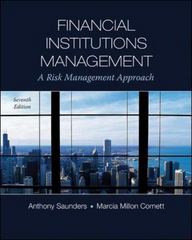Question
1) You are buying a house and need to borrow 216,355. The terms of the mortgage are: 15 years of monthly payments (with the first
1) You are buying a house and need to borrow 216,355. The terms of the mortgage are: 15 years of monthly payments (with the first payment occurring one month from today); no balloon payment due at the end; and the bank's (i.e. lender's) stated "APR" mortgage rate is 4% per year (with assumed monthly compounding because the payments occur monthly). What is your mortgage (i.e. amortization) payment? Enter value to the nearest penny.
2) The next Women's World Cup Finals Tournament was recently awarded to Australia/New Zealand. You would like to attend. You estimate the total cost for you to do so (flights, hotel stays, game tickets, food, and entertainment) will be 10,893. For ease of calculation, assume the 10,893 will be spent all at once, three years from now. Establish a monthly savings plan to achieve the goal of having enough money to spend that 10,893 at that time. Assume you plan to put equal-size monthly payments into an account that earns 2% per year with annual compounding. How big must each payment be (assuming the first one is one month from now)? Enter value to the nearest penny.
3) What is the price you should pay for the following semi-annual coupon bond (i.e. it makes interest payments every six months and is therefore compounding every six months)? It has an annual coupon rate of 5%, it matures in 15 years, and it has a face value of $1,000. Your (effective rate) required rate of return is 7.35%. Enter value to the nearest penny.
4)Which of these formulas accurately describe(s) the difference between the values of an ordinary annuity and an annuity due? Assume "r" stands for the interest rate in decimal form.
a) [PV of Annuity Due] = {[PV of ordinary annuity] + (r*[PV of Annuity Due])}
b) [PV of Annuity Due] = {[PV of ordinary annuity]*(1+r)}
c) [PV of Annuity Due] = {[FV of ordinary annuity]/r}
5) How long does it take to triple your money, if you invest it in an account with 14.2% return per year? Assume annual compounding. Type in your answer in years, with two digits to the right of the decimal.
6)
Choose the proper items (in the right order) to insert into the blanks, to make the sentence correct.
Zero coupon bonds have ____________ interest rate sensitivity than (regular) coupon bonds, because "price risk" and "re-investment rate risk" work in ______________ directions on bond values.
7)
Choose the proper items (in the right order) to insert into the blanks, to make the sentence correct.
If you like more money, then you prefer _______ frequent compounding on money you lend, and you prefer ______ frequent compounding on money you borrow.
a) more
b) less
8)
You plan to retire in 34 years. During each year of retirement, you want to have (i.e. withdraw) an amount of money with the same purchasing power that $64,765 has today. Inflation is expected to be 3.1% per year from now on (i.e. forever).
How much money do you need (to withdraw) in the first year of retirement (34 years from today)?
Round your answer to the nearest dollar.
9)
Assume you need $107,102 in the first year of retirement. Call it CF1. Note that you withdraw that money 35 years from today (t = 35 on a full retirement-plan timeline). Now assume you will keep your retirement savings (nest egg) in an investment that generates a return of 4% per year, during each year of your retirement and in the year before it starts. You plan to be retired for 27 years. You will continue to need the same purchasing power (during each year of retirement) that $107,102 represents in the first year of retirement. Inflation will remain at 3% per year forever. How much money do you need to have in your retirement account, one year before your retirement starts (this helps with timing issues), to fund (or finance) this stream of withdrawals? [i.e. what is the nest egg size at t=34?]. Round to the nearest dollar.
10) Assume a nest egg "goal" size at t = 34 is $3,479,354. Also assume that you will save money in an investment that earns 5% per year until t = 34, to reach your goal. You will make your first savings payment (into the investment) in one year (CF1). You will grow your annual payments by 1.5% per year. You will make 34 annual payments. How big must your first savings payment be, to reach your goal? Round to the nearest dollar.
Step by Step Solution
There are 3 Steps involved in it
Step: 1

Get Instant Access to Expert-Tailored Solutions
See step-by-step solutions with expert insights and AI powered tools for academic success
Step: 2

Step: 3

Ace Your Homework with AI
Get the answers you need in no time with our AI-driven, step-by-step assistance
Get Started


